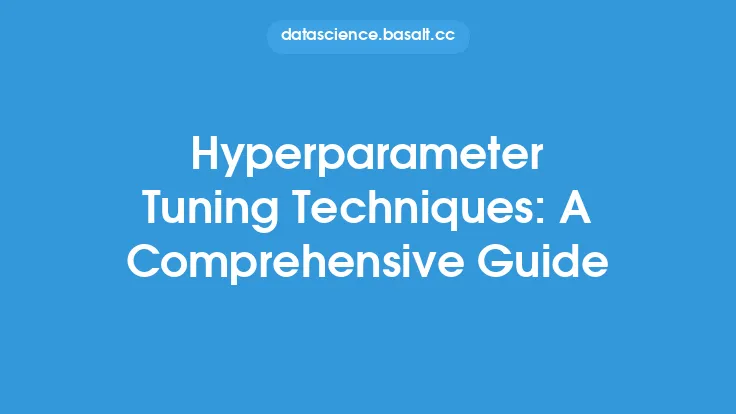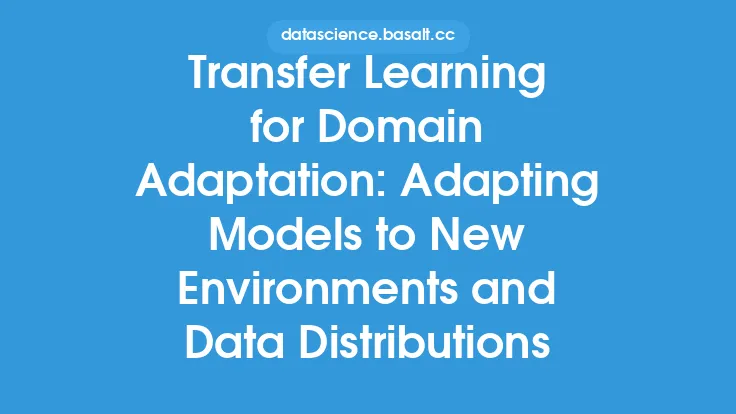Transfer learning is a fundamental concept in machine learning that enables the reuse of pre-trained models on new, but related tasks. This technique has revolutionized the field of artificial intelligence by allowing developers to leverage the knowledge and features learned by a model on one task and apply them to another task, thereby reducing the need for large amounts of training data and computational resources. In this article, we will delve into the world of transfer learning, exploring its techniques, applications, and benefits, as well as providing a comprehensive overview of the underlying concepts and mechanisms.
Introduction to Transfer Learning Techniques
Transfer learning techniques can be broadly categorized into two main types: feature extraction and fine-tuning. Feature extraction involves using a pre-trained model as a feature extractor, where the pre-trained model is used to extract features from the input data, and then a new classifier or regressor is trained on top of these features. Fine-tuning, on the other hand, involves adjusting the pre-trained model's weights to fit the new task, by adding new layers or modifying the existing ones. Both techniques have their own strengths and weaknesses, and the choice of technique depends on the specific problem and dataset.
Applications of Transfer Learning
Transfer learning has a wide range of applications across various domains, including computer vision, natural language processing, and speech recognition. In computer vision, transfer learning is used for image classification, object detection, and segmentation tasks. For example, a pre-trained model on ImageNet can be fine-tuned for a specific image classification task, such as classifying medical images or self-driving car images. In natural language processing, transfer learning is used for text classification, sentiment analysis, and language translation tasks. For instance, a pre-trained language model like BERT can be fine-tuned for a specific text classification task, such as spam detection or sentiment analysis.
Benefits of Transfer Learning
The benefits of transfer learning are numerous. Firstly, it reduces the need for large amounts of training data, which can be time-consuming and expensive to collect. Secondly, it reduces the computational resources required for training a model from scratch, making it more efficient and cost-effective. Thirdly, it enables the reuse of pre-trained models, which can save a significant amount of time and effort. Finally, transfer learning can improve the performance of a model by leveraging the knowledge and features learned by the pre-trained model, resulting in better accuracy and generalization.
Transfer Learning Architectures
Several architectures are commonly used for transfer learning, including convolutional neural networks (CNNs), recurrent neural networks (RNNs), and transformers. CNNs are widely used for computer vision tasks, such as image classification and object detection. RNNs are used for sequential data, such as text, speech, or time series data. Transformers are used for natural language processing tasks, such as language translation and text classification. These architectures can be pre-trained on large datasets and then fine-tuned for specific tasks, making them highly effective for transfer learning.
Pre-Trained Models for Transfer Learning
Several pre-trained models are available for transfer learning, including VGG16, ResNet50, and BERT. These models have been pre-trained on large datasets, such as ImageNet and Wikipedia, and can be fine-tuned for specific tasks. VGG16 and ResNet50 are commonly used for computer vision tasks, while BERT is used for natural language processing tasks. Other pre-trained models, such as Word2Vec and GloVe, are used for text classification and sentiment analysis tasks. These pre-trained models can be easily integrated into transfer learning pipelines, making it easy to leverage their knowledge and features.
Evaluating Transfer Learning Models
Evaluating transfer learning models involves assessing their performance on the target task. Several metrics are used to evaluate the performance of transfer learning models, including accuracy, precision, recall, F1-score, and mean squared error. These metrics provide insights into the model's ability to generalize to new data and its performance on the target task. Additionally, techniques such as cross-validation and bootstrapping can be used to evaluate the model's performance and robustness.
Challenges and Limitations of Transfer Learning
Despite its benefits, transfer learning also has several challenges and limitations. One of the main challenges is the risk of overfitting, which can occur when the pre-trained model is too complex or has learned features that are not relevant to the target task. Another challenge is the need for large amounts of labeled data, which can be time-consuming and expensive to collect. Additionally, transfer learning can be sensitive to the choice of pre-trained model, hyperparameters, and fine-tuning strategy, requiring careful tuning and experimentation.
Future Directions of Transfer Learning
The future of transfer learning is exciting and rapidly evolving. Several areas of research are currently being explored, including few-shot learning, meta-learning, and transfer learning for multimodal data. Few-shot learning involves learning from a few examples, while meta-learning involves learning to learn from multiple tasks. Transfer learning for multimodal data involves transferring knowledge across different modalities, such as text, images, and speech. These areas of research have the potential to further improve the performance and efficiency of transfer learning models, enabling them to be applied to a wider range of tasks and domains.
Conclusion
Transfer learning is a powerful technique that has revolutionized the field of machine learning. By leveraging pre-trained models and fine-tuning them for specific tasks, transfer learning enables the reuse of knowledge and features learned by a model on one task and applies them to another task. The benefits of transfer learning are numerous, including reduced need for large amounts of training data, reduced computational resources, and improved performance. While there are challenges and limitations to transfer learning, the future directions of research are exciting and rapidly evolving, with potential applications in few-shot learning, meta-learning, and transfer learning for multimodal data. As the field of machine learning continues to evolve, transfer learning is likely to play an increasingly important role in enabling the development of more accurate, efficient, and effective models.





